RESEARCH INTERESTS
My lab group studies the ecology of infectious disease. From disease in conservation and human health to the evolution of parasite host range and virulence, we focus on questions with a theoretical basis and an applied focus. We tend to focus on interactions within or between individual hosts and how they scale up to population-level outcomes. I am particularly interested in the relative importance of factors that influence disease transmission such as host community composition, environmental conditions, and heterogeneity in susceptibility. Most of our research focuses on the transmission dynamics and ecology of amphibian pathogens, especially ranaviruses, but we continue to work to understand the ecology of ticks and tick-borne disease in small mammal communities and as a function of climatic conditions.
